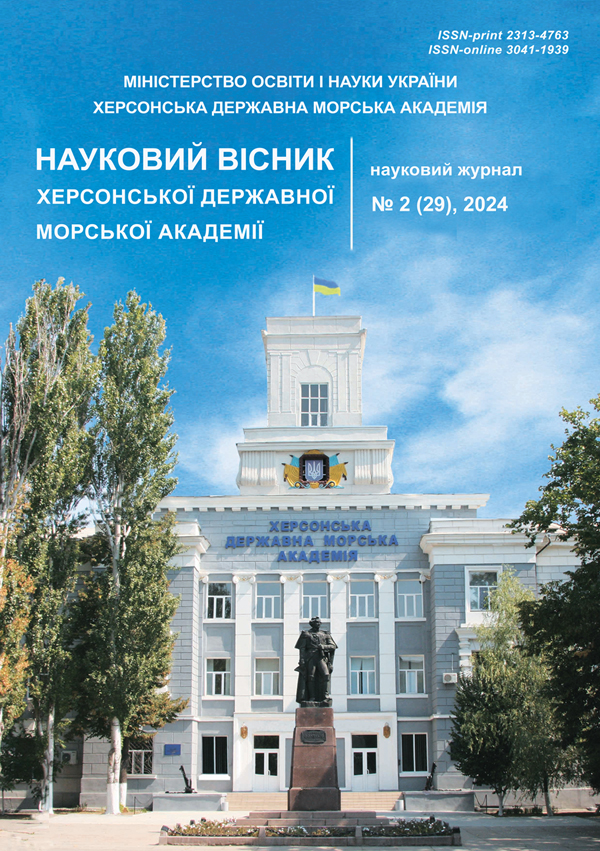FEATURES OF AUTOMATION OF UNMANNED SURFACE-UNDERWATER BOAT OF TRANSPORT TYPE
https://doi.org/10.33815/2313-4763.2024.2.29.035-048
Abstract
The purpose of the work is to supplement the existing classification of marine unmanned vehicles by introducing unmanned surface-underwater boats into it, to determine their main features as objects of automatic control and to form a general set of tasks for the synthesis of automated and automatically controlled systems, as well as to develop a generalized structure of the automatic control system for one of the key systems of an unmanned surface-underwater boat – the air supply system to the boat's thermal engine during its underwater movement. To achieve this goal, the hierarchical classification method was used to supplement the existing classification of marine unmanned vehicles, and the system approach method was used to formulate tasks for the synthesis of control systems for such boats. The result of the study is the addition of the classification of marine unmanned vehicles, which includes a new type of marine unmanned vehicles, as well as their division into types, categories and classes according to their purpose. It is shown that when developing the structure of the automatic control system for an unmanned surface-underwater boat, it is advisable to divide it into executive, program, adaptive, tactical and strategic levels. A general set of tasks for the synthesis of the control system for unmanned surface-underwater boats is proposed, consisting of the task of controlling the spatial movement of the boat as a solid body that can move on the sea surface and under water, the task of controlling the boat's energy system, the task of controlling the boat's information system and the task of controlling the boat's sea mission as a whole. For each task, a list of functional subtasks has been developed that cover the main processes of boat automation. Taken together, the developed list of tasks forms a scientific and technical basis for the development of automated and automatic boat control systems in all basic modes of its use as a means of transport. The scientific novelty is formed by the improved classification of marine unmanned vehicles, the first proposed general set and components of the synthesis problems of automatic control systems for a marine surface-underwater boat. The practical significance of the research lies in the scientific structuring of design work on the creation of a new type of marine robotics, which makes it possible to systematically carry out further design work on the development of automatic control systems for an unmanned surface-underwater boat.
References
2. Marine Control Systems for USV, UUV, ROV. Overview (2023). Technology Editor. https://www.unmannedsystemstechnology.com/expo/marine-control-systems/.
3. Universal Autonomous Control and Management System for Multipurpose Unmanned Surface Vessel (2019). Polish Maritime Research, 26(101). Pp. 30–39. https://doi.org/10.2478/ pomr-2019-0004. https://www.researchgate.net/publication/331988419_Universal_Autonomous_ Control_and_ Management_System_for_Multipurpose_Unmanned_Surface_Vessel.
4. Hyunjoon Cho, Sang-Ki Jeong, Dae-Hyeong Ji, Ngoc-Huy Tran, Mai The Vu, Hyeung-Sik Choi (2020). Study on Control System of Integrated Unmanned Surface Vehicle and Underwater Vehicle. Sensors, 20(9), 2633; https://doi.org/10.3390/s20092633.
5. Fernando Sotelo-Torres, Laura V. Alvarez and Robert C. Roberts (2023). An Unmanned Surface Vehicle (USV): Development of an Autonomous Boat with a Sensor Integration System for Bathymetric Surveys. Sensors, 23, 4420. https://doi.org/10.3390/s23094420.
6. Xiangen Bai, Bohan Li, Xiaofeng Xu, Yingjie Xiao (2022). A Rewiew of Current Research and Advances in Unmanned Surface Vehicles. Journal of Marine Science and Application. 21, 47–58. https://doi.org/10.1007.
7. Innespace Seabreacher. https://en.wikipedia.org/wiki/Innespace_Seabreacher.
8. Semi-submersible Jet Shark takes multiple passengers on a thrill ride. https://www.startupselfie.net/2023/02/08/jet-shark-semi-submersible-multiple-passengers-thrill-ride/.
9. DRIX SERIES UNCREWED SURFACE VEHICLES. https://www.ixblue.com/wp-content/uploads/2023/03/brochuredrix-series-webcompressed.pdf.
10. Navy Large Unmanned Surface and Undersea Vehicles: Background and Issues for Congress (2023). https://sgp.fas.org/crs/weapons/R45757.pdf.
11. U sviti ye 134 typy morskykh droniv, to chym osoblyvi nashi katery-kamikadze. https://defence-ua.com/weapon_and_tech/u_sviti_je_134_tipi_morskih_droniv_to_chim_osoblivi_ nashi_kateri_kamikadze-12842.html.
12. Doktryna Viiskovo-Morskykh Syl Zbroinykh Syl Ukrainy. VKP 7(3)-00(13).01 (2021). Zatverdzhena Holovnokomanduvachem Zbroinykh Syl Ukrainy 19.01.2021 r. https://ivms.mil.gov.ua/wp-content/uploads/2021/12/doktryna_vijskovo-morski-syly-zbrojnyh-syl-ukrayiny.pdf.
13. Tymchasova klasyfikatsiia morskykh bezekipazhnykh aparativ (system, kompleksiv) u Viiskovo-Morskykh Sylakh Zbroinykh Syl Ukrainy, yaki pryimaiutsia chy ye na ozbroienni Viiskovo-Morskykh Syl Zbroinykh Syl Ukrainy (2023). Zatverdzheno Nakazom komandyra viiskovoi chastyny A0456, 10.05.2023 r., №73.
14. Kurdiuk, S. V., Havryliuk, T. K., Sokolyk, Ya. M., Dzhezhulei, O. V. (2023). Osoblyvosti klasyfikatsii morskykh bezekipazhnykh pidvodnykh aparativ u Viiskovo-Morskykh Sylakh Zbroinykh Syl Ukrainy. Vyprobuvannia ta sertyfikatsiia, № 2(2). P. 30–36. https://doi.org/10.37701/ts.02.2023.04.
15. Pahl, G., Beitz, W., Feldhusen, J., Grote, K. H. (2006). Engineering Design: A Systematic Approach. Third Edition. Springer. https://www.amazon.co.uk/. Engineering-Design-Systematic-Approach-Pahl/dp/1846283183.
16. Blintsov, V. S., Sokolov, V. V. (2016). Suchasni zadachi avtomatyzatsii keruvannia bezekipazhnym nadvodnym katerom. Avtomatyka-2016: Materialy KhKhIII mizhnarodnoi konferentsii z avtomatychnoho upravlinnia, m. Sumy, 22–23 veresnia 2016 roku. Sumy : Sumskyi derzhavnyi universytet. P. 201–202.
17. Military Electronic Chart Display and Information System (ECDIS) Market Research Report Provides thorough Industry Overview, which offers an In-Depth. https://www.linkedin.com/pulse/military-electronic-chart-display-information-system-ecdis-jhpvc/.
18. Toru Katayama, Koji Suzuki (2003). A NEW SHIP MOTION CONTROL SYSTEM FOR HIGH-SPEED CRAFT. FAST2003: Proceedings of 7th International Fast Sea Transportation, Vol. 3. 7th–10th October, 2003, Ischia Italy. 9 Papers. https://www.researchgate.net/publication/318418286_A_NEW_SHIP_MOTION_CONTROL_SYSTEM_FOR_HIGH-SPEED_CRAFT.
19. Kantubhukta Dinesh, Joddumahanthi Vijaychandra, Seshasai Brundavanam, Kakinada Vedaprakash (2021). A Review on Control of the Underwater Vehicles. International Journal of Scientific Research in Engineering and Management (IJSREM), Volume 05, Issue 05. 6 pages. https://www.researchgate.net/publication/351371540_A_Review_on_Control_of_the_Underwater_Vehicles.
20. Fan Gao, Astrid H. Brodtkorb, Mehdi Zadeh, Sigrid Marie Mo (2024). Power management and optimization of marine hybrid propulsion systems: A combinator surface methodology. Ocean Engineering, Volume 309, Part 2, 2024, 118354. https://doi.org/10.1016/j.oceaneng.2024.118354.
21. Albert M. Bradley, M. D. Feezor, Hanumant Singh, F. Yates Sorrell (2001). Power systems for autonomous underwater vehicles. IEEE Journal of Oceanic Engineering, November. 26(4). Papers 526–538. https://doi.org/10.1109/48.972089.






